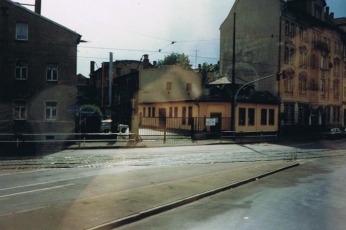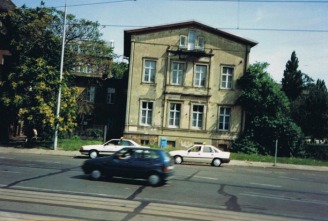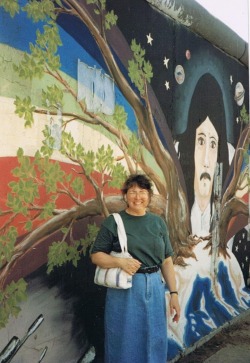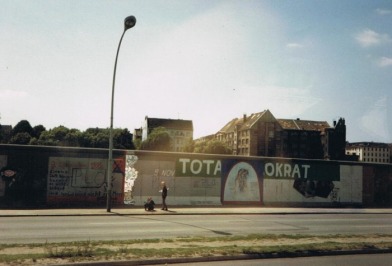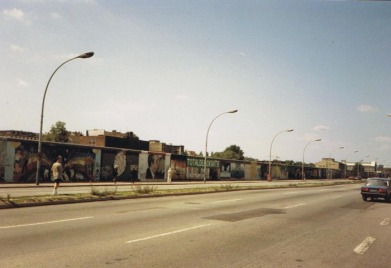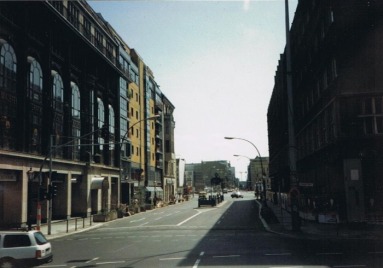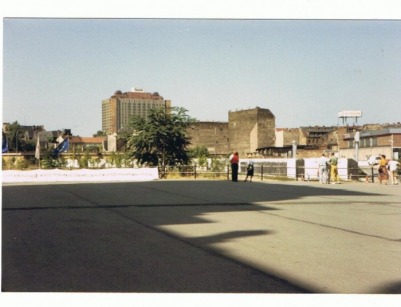Two things struck me, however, as I was researching this project:
1. The power of propaganda.
As television viewers, we all know how easy it is to sway large groups of people, but still, it’s stunning how easily East German authorities convinced people that walls and borders were there to protect them from the immoral and dangerous influences of the West.
Judging by the number who escaped or tried to, not all were fooled. But, if you listen carefully to the dialogue between guards and East Germans in the Mauerfall videos, you'll find evidence that many East Berliners still believed they were walled off for their own good.
I went to Berlin and Leipzig not long after reunification. It was still a mess.
You couldn’t place a phone call from east to west. You still had to carry a passport, or a visa provided by a hotel, which took your passport when you checked in. That practice made me very nervous since I had no way to call the US embassy in what-was-once the West, if that passport went missing.
Living conditions in East Germany were much worse than I expected. I had never before seen so many obviously disabled people in one place at the same time. Since my mother was crippled, I was very tuned into noticing such things. One day, I counted 40 physically disabled people on the streets of Leipzig. Many begged on street corners, at entrances to office buildings or in front of restaurants. These were young people -- many blind or with badly deformed limbs -- so these weren’t war wounds they were dealing with.
Coal was the home heating fuel of choice so the air stunk and, some days, it polluted the air so much you could barely see across the street.
Fences and gates marked many intersections. There were video cameras and loudspeakers at every turn. Recorded voices told you to stop, start, to not spit, smoke, run, or misbehave in any way. They may have told you more than that, but those were the only words I understood. I could hear loudspeakers barking all night all over the city, since I had to leave the windows open in my hotel room to keep cool.
Small towns were gated at every exit with concrete stanchions spaced just far apart to let a Trabant through, which meant there was no way anyone could simply drive from town to town without dealing with a guard. All movement within the country was watched and recorded.
Highway border crossings looked like American interstate toll plazas with gun towers. We passed an especially large one that had been shot up to smithereens.
I was in Leipzig the week the first green grocer opened. Lines of skinny and wan customers wrapped around the block to buy fresh produce, many for the first time. I went there to buy water every few days – at the advice of the hotel concierge – and stood in the quiet, very orderly line, waiting my turn to shop. They sold food we would never eat: moldy peaches, rusty lettuce, blackened bananas and overripe tomatoes, all at New York prices!
The Leipzigers we met loved their city, and boasted loudly about everything they could that set them apart from the rest of the country. Think New Yorkers. Texans. Californians. After all, this was home to Bach, Mendelssohn and Goethe, among other notables, and today is home to one of the world’s finest orchestras.
A tourguide boasted about the city’s main hospital, in particular. You’ll see it below. Aside from electrification, it didn’t look to me like much had changed since the 15th century, when it was built. Note: It wasn't tilted, I was shooting from a bus.
In spite of all the available firepower, attack dogs, machine guns, landmines, barbed wire, Stasi and whatever else they threatened people with, not one single shot was fired on the night of November 9, 1989.
Not long after der Berliner Mauerfall, citizens of Leipzig, Dresden and other eastern cities tested the waters and got the same response. Guards were either ambivalent about what to do, overwhelmed by the crowds or unwilling to stop them.
Kind of makes you wonder, doesn’t it?
Think of all the walls that are up today, in places like Israel, China, Korea, the US. Do you think we’ll see them come down in our lifetime? I certainly hope so.
